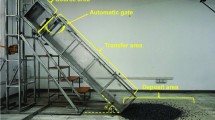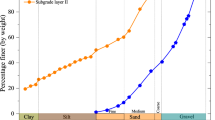Abstract
Liquefaction occurs in loose saturated sand layers, inducing quite considerable damage to the existing buildings and civil infrastructures. In the last few decades, scientific committees in geotechnical engineering have focused on methods for liquefaction remediation, using different ground improvement techniques based on various improvement principles. Deep soil mixing (DSM) with a grid pattern was developed in the 1990s for liquefaction mitigation, in which a grid of stabilized column walls performs the function of restricting the generation of excess pore water pressure (EPWP) by confining the movement of the soil particles during an earthquake. The effect of DSM improvement with a grid pattern on foundation settlement and EPWP generation was investigated parametrically herein, using a numerical model developed in GiD + OpenSees interface V2.6.0. The validity of the model was evaluated by comparing the results obtained from the numerical model with the results from an experimental centrifuge study. The three-dimensional finite element model estimated a 75% reduction in settlement of the foundation rested on the improved ground as compared to the unimproved case. The results also indicated that the grid wall spacing, the diameter of columns, soil relative density, and the shear modulus ratio between DSM columns and the enclosed soil play a vital role in the liquefaction occurrence and volumetric strains.











Similar content being viewed by others
Data availability
All data generated from the experimental results during this study are included in this published article DOI:10.3208/jgs.9.761.
References
Afacan K (2019) Estimation of excess pore pressure generation and nonlinear site response of liquefied areas. Geotech Eng Adv Soil Mech Foundation Eng:1–21. https://doi.org/10.5772/intechopen.88682
Amanta AS, Dasaka SM (2021) Air injection method as a liquefaction countermeasure for saturated granular soils. Transp Geotech 30:100622
Biot MA (1962) The mechanics of deformation and acoustic propagation in porous media. J Appl Phys 33(4):1482–1498. https://doi.org/10.1063/1.1728759
Chan AHC (1988) A unified finite element solution to static and dynamic problems in geomechanics. PhD. Dissertation, University College of Swansea, U.K
Ecemis N, Valizadeh H, Karaman M (2021) Sand-granulated-rubber mixture as a remedial measure for liquefaction-induced uplift of buried pipelines: a shaking-table study, Bulletin of Earthquake Engineering, April 2021
Elgamal A, Lu J, Forcellini D (2009) Mitigation of liquefaction-induced lateral deformation in a sloping stratum: three-dimensional numerical simulation. J Geotech Geoenviron Eng 135(11):1672e1682. https://doi.org/10.1061/(ASCE)GT.1943-5606.0000137
Elgamal A, Yang Z, Lai T, Kutter BL, Wilson DW (2005) Dynamic response of saturated dense sand in laminated centrifuge container. J Geotech Geoenviron Eng 131(5):598–609
Farouk A, Shahien MM (2013) Ground improvement using soil-cement columns: an experimental investigation. Alexandria Eng J 52(4):733–740. https://doi.org/10.1016/j.aej.2013.08.009
Jiaer WU, AM Kammerer, MF Riemer, RB Seed, and JM Pestana (2004) Laboratory study of liquefaction triggering criteria, 13th World Conference on Earthquake Engineering, Vancouver, Paper No. 2580
Hasheminezhad A, Bahadori H (2019) Seismic response of shallow foundations over liquefiable soils improved by deep soil mixing columns. Comput Geotech 110:251–273. https://doi.org/10.1016/j.compgeo.2019.02.019
Hamada M, Wakamatsu K (1997) Liquefaction-induced ground displacement triggered by quaywall movement. Soils found 38:85–95. https://doi.org/10.3208/sandf.38.Special85
Iwan WD (1967) On a class of models for the yielding behavior of continuous and composite systems. J Appl Mech ASTM 34:612–617
Kazuhiro K, Masayuki I (2017) Preventing liquefaction by using grid-form deep mixing walls on a liquefiable soil layer below a non-liquefiable layer. Proceedings of the 19th Int Conf Soil Mech Geotech Eng
Kitazume M, and Takahashi H (2010) Centrifuge model tests on effect of deep mixing wall spacing on liquefaction mitigation. 7th Intl. Conf. on Urban Earthquake Engineering (7CUEE) & 5th Intl. Conf. on Earthquake Engineering (5ICEE), Tokyo Institute of Technology, Tokyo, Japan, 473–478
Lacy S (1986) Numerical procedures for nonlinear transient analysis of two-phase soil system, Ph.D. Thesis, Princeton University, NJ, U.S.A
Lu J, Peng J, Elgamal A, Yang Z, Law KH (2004) Parallel finite element modeling of earthquake ground response and liquefaction. Earthq Eng Eng Vib 3(1):23–37
Lysmer J, Kuhlemeyer RL (1969) Finite dynamic model for infinite media. J Eng Mech Div 95:859–878
Madabhushi SPG (2014) Centrifuge modelling for civil engineers. Taylor & Francis, London
Mazzoni S, McKenna F, Scott MH, and Fenves GL (2009) Open system for earthquake engineering simulation user manual, University of California, Berkeley Calif. https://opensees.berkeley.edu/
Mroz Z (1967) On the description of anisotropic work hardening. J Mech Phys Solids 15:163–175
Namikawa T, Koseki J, Suzuki Y (2007) Finite element analysis of lattice-shaped ground improvement by cement mixing for liquefaction mitigation. Soils Found 47(3):559–576. https://doi.org/10.3208/sandf.47.559
Nguyen TV, Rayamajhi D, Boulanger RW, Ashford SA, Lu J, Elgamal A, and Shao L (2012) Effects of DSM grids on shear stress distribution in liquefiable soil, Proceedings Geo Congress 2012, State of the Art and Practice in Geotechnical Engineering, ASCE GSP 255, Oakland, CA, 1948–1957. https://doi.org/10.1061/9780784412121.200
Nguyen TV, Rayamajhi D, Boulanger RW, Ashford SA, Lu J, Elgamal A, Shao L (2013) Design of DSM grids for liquefaction remediation. J Geotech Geoenviron Eng ASCE 139(11):1923–1933
Papanikolaou VK, Kartalis-Kaounis T, Protopapadakis VK, Papadopoulos T (2017) GiD+OpenSees interface: an integrated finite element analysis platform. Aristotle University of Thessaloniki, Greece, Lab of R/C and Masonry Structures
Parra E (1996) Numerical modeling of liquefaction and cyclic mobility and dilative behavior in soil systems. Ph.D. dissertation, Dept. Civil Eng., Rensselaer Polytechnic Institute
Prevost JH (1985) A simple plasticity theory for frictional cohesionless soils. Soil Dyn Earthq Eng 4(1):9–17
Rayamajhi D, et al. (2012) Effect of discrete columns on shear stress distribution in liquefiable soil. Proc., Geo-Congress 2012: State of the Art and Practice in Geotechnical Engineering, ASCE, Reston, VA, 1908–1917. https://doi.org/10.1061/9780784412121.196
Suzuki Y, Satio S, Onimaru S, Kimura T, Uchida A, Okumura R (1996) Grid-shaped stabilized ground improve by deep cement mixing method against liquefaction for a building foundation. Tsuchi-to-Kiso, JGS 44(3):46–48 ((in Japanese))
Tokimatsu K, Mizuno H, and Kakurai M (1996) Building damage associated with geotechnical problems, Special Issues Soils Found 219-234. https://doi.org/10.3208/sandf.36.Special219
Tsukuni S, Uchida A, Honda T, Konishi K (2013) Dynamic centrifuge model test focused on the settlement of the residence improved with grid-form deep mixing walls. Japanese Geotech J 9(4):761–771. https://doi.org/10.3208/jgs.9.761 ((in Japanese))
Tsukuni S, Namikawa T (2015) Simulation analysis of grid-form ground improvement for preventing liquefaction among existing small houses. 14th Intl. Conf. on Computer Methods and Recent Advances in Geomechanics, Kyoto, Japan, Taylor and Francis-Balkema 631–636. https://doi.org/10.1201/b17435-109
Valizadeh H, Ecemis N (2022) Soil liquefaction–induced uplift of buried pipes in sand-granulated-rubber mixture: numerical modeling. Transp Geotech 33:100719
White W, Valliappan, Lee M (1977) Unified boundary for finite dynamic models. J Eng Mech Div 103:949–964
Yang Z (2000) Numerical modeling of earthquake site response including dilation and liquefaction. PhD dissertation, Dept. of Civil Engineering and Engineering Mechanics, Columbia University, New York
Yang Z, Lu J, Elgamal A (2008) OpenSees soil models and solid-fluid fully coupled elements: user’s manual. University of California, San Diego, Department of Structural Engineering
Zienkiewicz OC, Chan AHC, Pastor M, Paul DK, Shiomi T (1990) Static and dynamic behavior of soils: a rational approach to quantitative solutions: I. Fully saturated problems. Proc Royal Soc London Ser A Math Phys Sci 429:285–309
Kitazume M (2009) A parametric study on evaluation of the stability of column type DM improved ground, Proc. of International Symposium on Geoenvironmental Engineering, ISGE2009, pp 920–925
Author information
Authors and Affiliations
Corresponding author
Ethics declarations
Conflict of interest
The authors declare no competing interests.
Additional information
Responsible Editor: Zeynal Abiddin Erguler
Publisher’s note
Springer Nature remains neutral with regard to jurisdictional claims in published maps and institutional affiliations.
Rights and permissions
About this article
Cite this article
Rahmani, F., Hosseini, S.M., Khezri, A. et al. Effect of grid-form deep soil mixing on the liquefaction-induced foundation settlement, using numerical approach. Arab J Geosci 15, 1112 (2022). https://doi.org/10.1007/s12517-022-10340-x
Received:
Accepted:
Published:
DOI: https://doi.org/10.1007/s12517-022-10340-x




